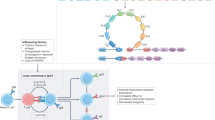Abstract
Both systemic and organ-specific autoimmune diseases are major manifestations of IgA deficiency (IgAD), the most common primary immunodeficiency. In addition, to discuss the clinical findings of IgAD patients, we proposed a hypothesis to explain the high association with autoimmune phenomena. Based on observations, interactions of monomeric IgA with FcαRI result in a partial phosphorylation of FcRγ-associated FcαRI, notably in the immunoreceptor tyrosine-based activation motif (ITAM) inducing the recruitment of the SHP-1 tyrosine phosphatase. This leads to deactivation of several activating pathways of the immune system including immunoreceptors that bear ITAM motif and ITAM-independent receptors. Consequently, inflammatory reactions and auto-immune process would be prevented.

Similar content being viewed by others
References
Woof JM, Kerr MA. The function of immunoglobulin A in immunity. J Pathol. 2006;208:270–82.
Corthesy B. Roundtrip ticket for secretory IgA: role in mucosal homeostasis? J Immunol. 2007;178:27–32.
Russell MW, Sibley DA, Nikolova EB, Tomana M, Mestecky J. IgA antibody as a non-inflammatory regulator of immunity. Biochem Soc Trans. 1997;25:466–70.
Conley ME, Notarangelo LD, Etzioni A. Diagnostic criteria for primary immunodeficiencies. Representing PAGID (Pan-American Group for Immunodeficiency) and ESID (European Society for Immunodeficiencies). Clin Immunol. 1999;93(3):190–7.
Conley ME, Notarangelo LD, Etzioni A. Representing PAGID and ESID. Diagnostic criteria for primary immunodeficiencies. Clinical Immunol. 1999;93(3):190–7.
Boyle JM, Buckley RH. Population prevalence of diagnosed primary immunodeficiency diseases in the United States. J Clin Immunol. 2007;27(5):497–502.
Carneiro-Sampaio MMS, Carbonare SB, Rozentraub RB, de Araújo MN, Riberiro MA, Porto MH. Frequency of selective IgA deficiency among Brazilian blood donors and healthy pregnant women. Allergol et Immunopathol. 1989;17(4):213–6.
Leiva LE, Zelazco M, Oleastro M, Carneiro-Sampaio M, Condino-Neto A, Costa-Carvalho BT, et al. Primary immunodeficiency diseases in Latin America: the second report of the LAGID registry. J Clin Immunol. 2007;27(1):101–8.
Weber-Mzell D, Kotanko P, Hauer AC, Goriup U, Haas J, Lanner N, et al. Gender, age and seasonal effects on IgA deficiency: a study of 7293 Caucasians. Eur J Clin Invest. 2004;34(3):224–8, Mar.
Ozkan H, Atlihan G, Genel F, Targan S, Gunvar T. IgA and/or subclass deficiency in children with recurrent respiratory infections and its relationship with chronic pulmonary damage. J Investig Allergol Clin Immunol. 2005;15:69–74.
Arkwright PD, Abinun M, Cant AJ. Autoimmunity in human primary immunodeficiency diseases. Blood 2002;99(8):2694–702.
Cunningham-Rundles C. Hematologic complications of primary immune deficiencies. Blood Rev. 2002;16:61–4.
Carneiro-Sampaio MMS, Coutinho A. Tolerance and autoimmunity: lessons at the bedside of primary immunodeficiencies. Adv Immunol. 2007;95:51–82.
Etzioni A. Immune deficiency and autoimmunity. Autoimmun Rev. 2003;2:364–9.
Sinclair D, Saas M, Turk A, Goble M, Kerr D. Do we need to measure total serum IgA to exclude IgA deficiency in coeliac disease? J Clin Pathol. 2006;59:736–9.
Cataldo F, Marino V, Ventura A, Bottaro G, Corazza GR. Prevalence and clinical features of selective immunoglobulin A deficiency in celiac disease: an Italian multicentre study. Gut 1998;42:362–5.
Badcock LJ, Clarke S, Jones PW, Dawes PT, Mattey DL. Abnormal IgA levels in patients with rheumatoid arthritis. Ann Rheum Dis. 2003;62:83–4.
Cassidy JT, Kitson RK, Seiby CL. Selective IgA deficiency in children and adults with systemic lupus erythematosus. Lupus 2007;16:647–50.
Koskinen S. Long-term follow-up of health in blood donors with primary selective IgA deficiency. J Clin Immunol. 1996;16(3):165–70.
Gerbase-Delima M, Pinto LC, Grumach A, Carneiro-Sampaio MM. HLA antigens and haplotypes in IgA-deficient Brazilian paediatric patients. Eur J Immunogenet. 1988;25:281–5.
Pan-Hammarstrom Q, Salzer U, Du L, Bjorkander J, Cunningham-Rundles C, Nelson DL, et al. Reexamining the role of TACI coding variants in common variable immunodeficiency and selective IgA deficiency. Nat Genet. 2007;39:429–30.
Castigli E, Wilson S, Garibyan L, Rachid R, Bonilla F, Schneider L, et al. Reexamining the role of TACI coding variants in common variable immunodeficiency and selective IgA deficiency. Nat Genet. 2007;39:430–1.
Cunningham-Rundles C. Physiology of IgA and IgA deficiency. J Clin Immunol. 2001;21:303–9.
Pasquier B, Launay P, Kanamaru Y, Moura IC, Pfirsch S, Ruffie C, et al. Identification of FcalphaRI as an inhibitory receptor that controls inflammation: dual role of FcRgamma ITAM. Immunity 2005;22:31–42.
Monteiro RC, Van De Winkel JG. IgA Fc receptors. Annu Rev Immunol. 2003;21:177–204.
van Egmond M, Damen CA, van Spriel AB, Vidarsson G, van Garderen E, van de Winkel JG. IgA and the IgA Fc receptor. Trends Immunol. 2001;22:205–11.
Kanamaru Y, Pfirsch S, Vrtovsnik F, Loirat C, Deschenes G, Guérin-Marchand C, et al. Inhibitory ITAM signaling by FcαRI-γ controls multiple activating responses and prevents renal inflammation1. J Immunol 2008 (in press).
Chevailler A, Monteiro RC, Kubagawa H, Cooper MD. Immunofluorescence analysis of IgA binding by human mononuclear cells in blood and lymphoid tissue. J Immunol. 1989;142:2244–9.
Acknowledgements
This work is supported by Fundação de Amparo à Pesquisa do Estado de São Paulo-FAPESP-grant 2002/05880-4.
Author information
Authors and Affiliations
Corresponding authors
Rights and permissions
About this article
Cite this article
Jacob, C.M.A., Pastorino, A.C., Fahl, K. et al. Autoimmunity in IgA Deficiency: Revisiting the Role of IgA as a Silent Housekeeper. J Clin Immunol 28 (Suppl 1), 56–61 (2008). https://doi.org/10.1007/s10875-007-9163-2
Received:
Accepted:
Published:
Issue Date:
DOI: https://doi.org/10.1007/s10875-007-9163-2




